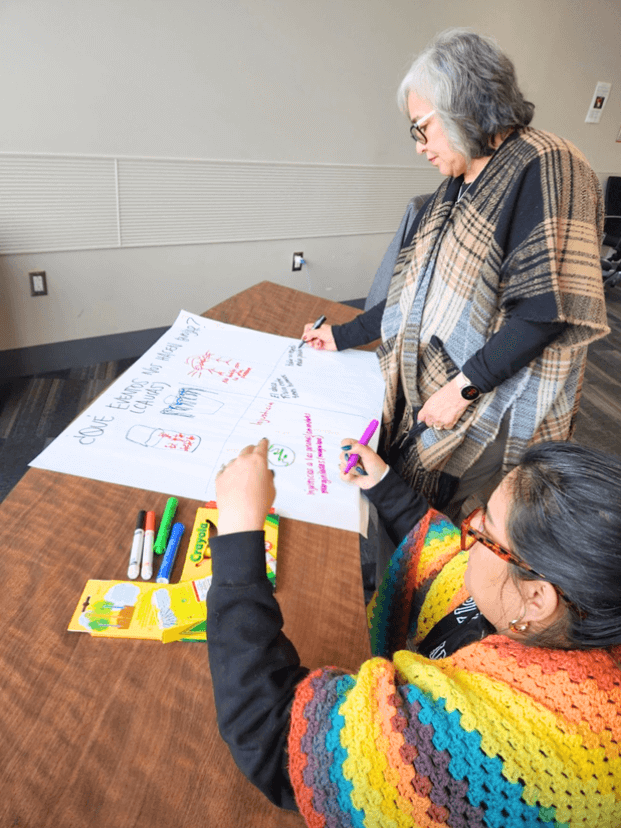Reflections on an Unforgettable Experience with the Bienvenido Program

MCN's Pamela Secada-Sayles, MPH, shares her story at the Bienvenido training.
Recently, I had the privilege of traveling to Omaha, Nebraska, along with MCN’s Pamela Secada-Sayles, MPH, to participate in a facilitator training for the Bienvenido Program, led by the inspiring Gilberto Pérez Jr., EdD. This culturally relevant initiative seeks to support immigrant communities as they navigate the challenges and opportunities of life in the United States. With a focus on mental health, resilience, and empowerment, Bienvenido provides essential tools for individuals and families to build strong foundations in their new communities.

Practical Strategies for Community Engagement
The sessions underscored the many methods to successfully support immigrant communities. Here are a few they shared:
- Pláticas, or community-led discussions are a critical aspect to any community intervention or training. Facilitators must meet the community where they are and give the community tools to be empowered to lead the direction of a project to make sure that the training is what the community really needs. Read examples of how people utilize pláticas here and here. Read more on how to bring in the community in MCN’s Designing Community-Based Communication Campaigns Manual. Read the NACES Pilot Project Report for more community tools and evidence-based interventions on ACEs.
- Storytelling and visual storytelling can help communities envision how their own community can benefit from a program or training. This strategy can be especially helpful for participants with who can’t read or write as it still allows engagement in concepts and ideas through images, drawing, and narratives rather than text. MCN’s Your Voice Matters: A Photo Voice Project is an example of storytelling through the use of photographs. Relate Lab also uses storytelling in their work. Read how to use the strategy to advance health here.
- Infusion of the arts can help participants articulate their feelings in non-verbal ways. Drawing, role playing, and the use of stress balls were all given as examples of how to include art and movement into a training. These creative approaches are sometimes called dinámicas, or interactive group activities. Read how MHP Salud incorporates dinámincas in their trainings and community engagements here.

A Journey of Learning and Growth
Through guided self-reflection and discussion, we deepened our understanding of the struggles many immigrants face and the importance of fostering environments that encourage healing and empowerment.
One of the topics explored was how risk and protection factors shape the experiences of immigrants as they navigate a new life. We examined how risks such as social isolation, family disorganization, economic hardship, and peer pressure can create barriers to emotional well-being, while protective factors -- strong family ties, access to education, community support, and healthy coping skills -- serve as essential foundations for resilience. By addressing these factors, we raise awareness and cultivate meaningful connections that support long-term integration, ensuring that every individual has the tools and support they need to thrive.
This training reinforced the notion that cultural humility is not a destination but an ongoing practice that requires continuous effort to recognize and challenge our own biases while remaining open to learning from the lived experiences of others. Cultural humility strategies included prioritizing self-reflection, mutual respect, and the understanding that true cultural knowledge is not something we acquire once but something we cultivate through meaningful interactions and genuine curiosity.

Taking the Experience Further
Without a doubt, Pamela and I returned home with new knowledge, tools, and, most importantly, a renewed sense of purpose. This training reaffirmed why we do this work and inspired us to continue improving our practices. The challenge is to implement what we’ve learned, share these resources with our communities, and continue creating safe spaces where people feel seen, heard, and supported.
A special thank you to Gilberto Pérez, Athena Ramos, PhD, the trainers, and the organizers for their dedication, and our fellow trainees for the inspiring conversations and connections.
And You? How Do You Contribute to Your Community’s Well-Being?
Each of us plays a key role in building spaces of support and growth. Have you participated in similar programs? What strategies have you found effective in connecting with communities?
More Resources
Learn more about the Bienvenido program and learn skills and strategies:
- Community-Defined Evidence as a Framework for Equitable Implementation, an article in Stanford Social Innovation Review
- Bienvenido, an introduction to the program on the University of Minnesota Extension website.
- Filling a Gap in Mental Health Care for Minnesota’s Migrant Workers, an article in the Daily Yonder about Bienvenido
- Watch a webinar featuring Gilberto Perez presented by the Consulado de Mexico
- Watch an interview with Gilberto Perez (in Spanish) with the Goshen Chronicles
- Log in to post comments
